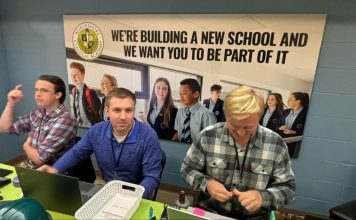The COVID-19 pandemic has provided an unprecedented opportunity to rethink education in America. Instead of hoping for a return to “normal,” let’s learn from what has worked – and what has not – to make lasting improvements and create a more resilient system, one that can adapt to any challenge families may face in the future.
The first step toward realizing a more resilient and family-centered system is to reimagine how we fund education. In short, it’s time to start funding families, not the buildings that are meant to serve them.
Americans spend at least $720 billion on education each year. At around $13,000 per child, that puts the U.S. among the highest-spending countries in the world.
Instead of providing this benefit directly to families – as we do for higher education, childcare, and health care – in K-12, we send this money directly to school buildings. Taxpayer dollars are collected and sent to a central office, and zones are drawn around individual schools where students are required to attend or forfeit the funds raised for their education.
The pandemic has exposed the flaws in this system. School closures, loss of childcare, and difficulties transitioning to online and hybrid-learning models are having devastating effects on children. According to one report, an estimated 3 million students have received no formal education since schools closed in March. That’s the equivalent of every school-aged child in Florida failing to show up for school.
The economic impact on students is estimated at $110 billion in lost future earnings each year. Unsurprisingly, this decline in learning has been felt more deeply by children in low-income families.
These challenges might seem insurmountable, and many of us look forward to the day when we can return to “normal.” But why would we want to return to a status quo that has proven a failure during a time of crisis? While we may not encounter an international crisis of the scope and scale of COVID-19, families face immeasurable local and personal crises each year.
This is a time to learn from innovations that have proven successful and integrate them into the system moving forward.
One of the biggest innovations during the pandemic has been the proliferation of individualized education. Families with resources – financial and otherwise – are taking matters into their own hands. They are hiring tutors, forming learning pods, enrolling in microschools, sharing childcare, reimagining after-school programs, and rearranging their lives to provide the continued learning opportunities that many children have lacked for months.
These unconventional models may yield academic benefits. Researchers from Opportunity Insights analyzed data from 800,000 students enrolled in an online math curriculum used by schools before and during the pandemic. The researchers found that students in low-income neighborhoods saw a 9% decline in math progression between January and April. Meanwhile, students from wealthy ZIP codes saw a 40% improvement over the same period.
In other words: in the spring, with schools closed during the pandemic, students in some wealthy families may have progressed academically at higher rates than if the schools had remained open.
This is raising understandable equity concerns from advocates concerned about widening gaps between low- and high-income students. But in a situation where some students are progressing and others are falling behind, the solution isn’t to move everyone to the middle. It’s to give those falling behind access to the same type of learning that is allowing others to thrive.
The sort of family-directed, individualized education taking place during the pandemic is likely to expand its presence in American life. As an Atlantic article observed, “COVID-19 is a catalyst for families who were already skeptical of the traditional school system – and are now thinking about leaving it for good.” The author of that piece, Emma Green, recently said in an interview that home-based, unconventional methods of education are getting “a flood of interest from parents of all kinds.” Early data seems to confirm this, with large upticks in families opting out of school systems to pursue homeschooling.
To create a more effective and more resilient education system, we must learn from what has proven effective during the pandemic – namely, the ability of those with resources to identify and pursue a variety of individualized learning opportunities to meet children’s needs. To provide these same opportunities for all families, governments should prioritize direct grants to families, education spending accounts, refundable tax credits, and myriad other ways to get money into the hands of families so they can build an education that fits their needs.
The way in which we currently fund education is blocking equal access to these learning opportunities. To expand that access, we need to fund families, not school buildings.
Adam Peshek / RealClearWire
Go to Source
Reposted with permission













![Mandela Barnes Said ‘Reducing Prison Populations is Now Sexy’ [VIDEO] Reducing Prison Populations is Now Sexy](https://www.wisconsinrightnow.com/wp-content/uploads/2022/09/Collage-Maker-14-Sep-2022-11.44-AM-356x220.jpg)







![Author Exposes the Tragic Realities of the 2020 Riots & the ‘Gaslighting of America’ [REVIEW] julio roses](https://www.wisconsinrightnow.com/wp-content/uploads/2025/11/MixCollage-21-Nov-2025-02-08-PM-8145-356x220.jpg)











